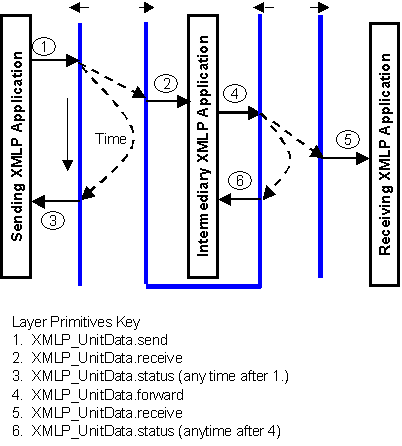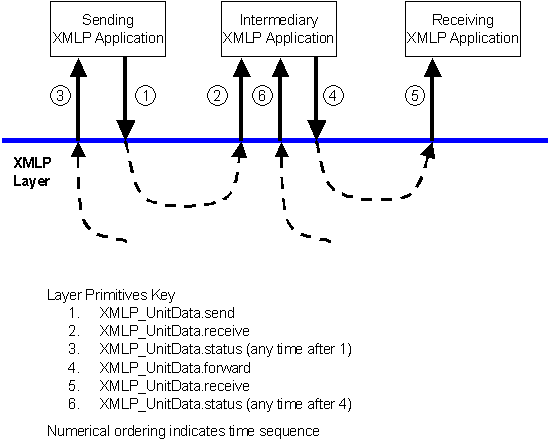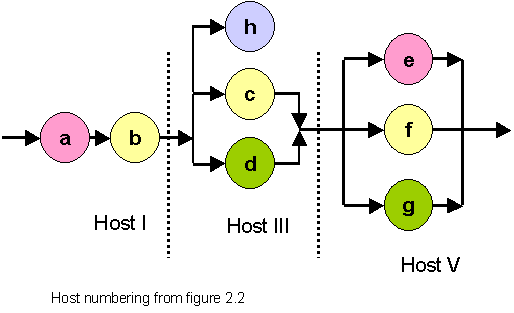This section focuses on the definition of an
abstract interface between the XML protocol applications and the
XML protocol layer. It needs to be remembered that the layer
interface described in this section is abstract - its purpose is to
enable description, not to constrain implementation.
The services provided by the XML protocol layer are
modeled a single operation. XMLP_UNITDATA provides services to
sending, intermediary and receiving XML protocol applications.
3.1 XMLP_UnitData Operation
XMLP_UnitData is a best effort one-way message transfer
operation with message correlation. Multiple message transfer
operations can be correlated in various ways to form message
exchange patterns like request/response, and long-lived
dialogs.
The XMLP_UnitData operation is modeled by four primitives
(events). Each primitive models a transmission, reception or status
event at interface between an XML protocol application and an
XML protocol processor:
XMLP_UnitData.send( To, [ImmediateDestination], Message, [Correlation], [BindingContext]);
XMLP_UnitData.receive( [To], [From], Message, [Correlation], [BindingContext]);
XMLP_UnitData.status( [From], Status, [BindingContext]);
XMLP_UnitData.forward( [ImmediateDestination], Message, [BindingContext]);
All parameters are detailed in
3.2 Operation Parameters.
Conceptually the XMLP_UnitData operation encapsulates the
transmission of an XML protocol message from a sending XML protocol
application to a receiving XML protocol application. The principal
conceptual difference between sending and forwarding an XML
protocol message is that, from a message correlation point of view,
sending generates a new message whereas forwarding passes on an
existing message. Conceptually the forwarded message is the same
message as previously received although the action of intermediary
processing may have changed the value of the message.
Figure 3.1 below illustrates the normal
use of these primitive at the sending and receiving XML protocol
applications.

Figure 3.1 XMLP_UNITDATA Operation
The operation is best effort which means that it can fail
silently with the loss of the message in transit. A lost
message may have been partially processed at an intermediary XML
protocol application. The success or failure of the operation is
reported via the XMLP_UnitData.status primitive. In some
circumstances it may only be possible to report that a message has
been sent. In other circumstances it may be possible to report that
a message has or has not been delivered to its ultimate
recipient.
XMLP_UnitData.send is invoked by the sending XML protocol
application and directed at the local sending XML protocol
processor to start a one-way transfer operation.
Upon receipt of this primitive by the sending XML protocol
processor an XML protocol message is transferred from the sending
XML protocol processor toward the receiving XML protocol processor
(possibly via intermediary XML protocol processors).
This primitive differs from the .forward
primitive in that it is used by the initial sender of an XML protocol message to send a new
message.
XMLP_UnitData.receive is invoked by the receiving XML
protocol processor and directed at a local receiving
XML protocol application to deliver a received XML protocol
message.
This primitive is invoked as a result of the arrival of an XML
protocol message from the sending XML protocol processor (via the
underlying protocol layers).
XMLP_UnitData.status is used to report on the delivery status
of the operation to the sending XML protocol application. This
primitive may be used to report to the sending XML protocol
application on the success or failure to send and deliver a message
to the receiving XML protocol application. In general, it is not
possible to assert that a message has been delivered to the
receiving XML protocol application without engaging in further
interactions. With care it is possible to assert definite failure
to deliver provided that circumstances are such that there is no
possibility of subsequent delivery. From the point-of-view of the
initiating XML application the operation has completed once this
primitive has been invoked.
XMLP_UnitData.forward is invoked by an intermediary XML
protocol application once it has completed intermediary processing
of a message in transit and directed at the local intermediary XML
protocol processor.
In the event of success the message is forwarded to its next
destination, as designated by the ImmediateDestination parameter if
given. Alternatively an implementation or configuration dependent
method may be used to select the next recipient of the message
along a path.
In the event of failure, the message in transit is discarded. A
correlated fault message may be generated by the intermediary XML
protocol application and sent toward the originator of the failed
message.
This primitive differs from the
.send primitive in that it is used by an intermediary XML
protocol application to forward an existing XML protocol message
received by the intermediary XML protocol application.
An XML protocol application may engage in multiple concurrent
operations with the same or different intermediary and/or receiving
XML protocol applications. These concurrent operations are
independent and the order in which they are processed by the
receiving and intermediary applications may be different from the
order in which they are invoked or complete at the sending XML
protocol application.
3.1.1 Correlation at Sending and Receiving XML Protocol Applications
The Correlation parameter provides a
general mechanism by which richer message exchange patterns such as
request-response and request/multi-response can be derived on top
of the one-way message exchange pattern of the XMLP_UnitData
operation. The mechanism by which correlation is determined
is not specified in this abstract model.
Message correlation may be determined through:
-
the exploitation of features in the underlying protocol eg. the
request/response nature of HTTP;
-
mechanism introduced either by the XMLP processor to operate
across multiple possible underlying protocols.
-
mechanism introduced by a binding to a particular underlying
protocol within the domain of the underlying protocols own header
extension mechanism.
When included in an
XMLP_UnitData.send primitive
Correlation.MessageRef indicates that the XML protocol message
being sent is a direct consequence of the processing of an XML
protocol message previously received by the sending XML protocol
application and referenced locally by Correlation.MessageRef.
Likewise, when included in an
XMLP_UnitData.receive primitive Correlation.MessageRef indicates
that the message being received is a direct consequence of the
processing of a XML protocol message previously sent by the
receiving XML protocol application and referenced locally by Correlation.MessageRef.
Failures that arise during message processing at the recipient
or at intermediary XML protocol applications may result in the
generation of fault messages directed toward the originator of the
message whose processing gave rise to the fault. Such fault
messages are a direct consequence of the faulted message and this
should be indicated through the use of the
Correlation parameter.
3.1.2 XMLP_UnitData Operation through Intermediaries
Conceptually an XML protocol intermediary does not generate a
new XML protocol message, it operates on an XML protocol message in
transit. Thus the received message and the forwarded message are
regarded as the same message although the intermediary may change
the value of the message.
Figure 3.2 shows the normal behaviour of
an XML_UnitData operation through an intermediary in the absence of
fatal failures. The three vertical lines represent the local XML
protocol layer boundaries and the small arrows above denote the
up/down orientation of the boundary. Figure
3.3 below shows an alternate representation of the same
scenario.
The scenario depicted in figures 3.2and 3.3. show just a single intermediary interposed
in the operation however the principle extends to an arbitrary
number of intermediaries.

Figure 3.2 Normal XMLP_UnitData operation through an Intermediary

Figure 3.3 Normal XMLP_UnitData operation through and Intermediary (alternate treatment)
It is worth noting that the
XMLP_UnitData.status is generated from within the XML protocol
layer. It may indicate anything from the mere fact that the message
has been sent or forwarded by the sending node; that its has been
received and/or sent from the intermediary node; or that it has
indeed been delivered to the ultimate recipient node. What it means
in a given circumstance will depend upon the capabilities of the
underlying communications protocols used to construct the message
path. The strongest thing that it can indicate is the failure to
deliver an XML protocol message to its ultimate recipient.
3.1.3 Message Correlation at Intermediary XML Protocol Applications
The Correlation.MessageRef
sub-field of the optional
Correlation parameter on a
XMLP_UnitData.receive primitive carries a local abstract
reference to an XML protocol message that was previously forwarded
by this intermediary XML protocol application. The current message
is a direct consequence of the processing of that earlier forwarded
message.
Typically this will arise when an application level response
travels along a path that passes through one or more of the same
intermediary XML protocol applications that the corresponding
request passed through earlier.







